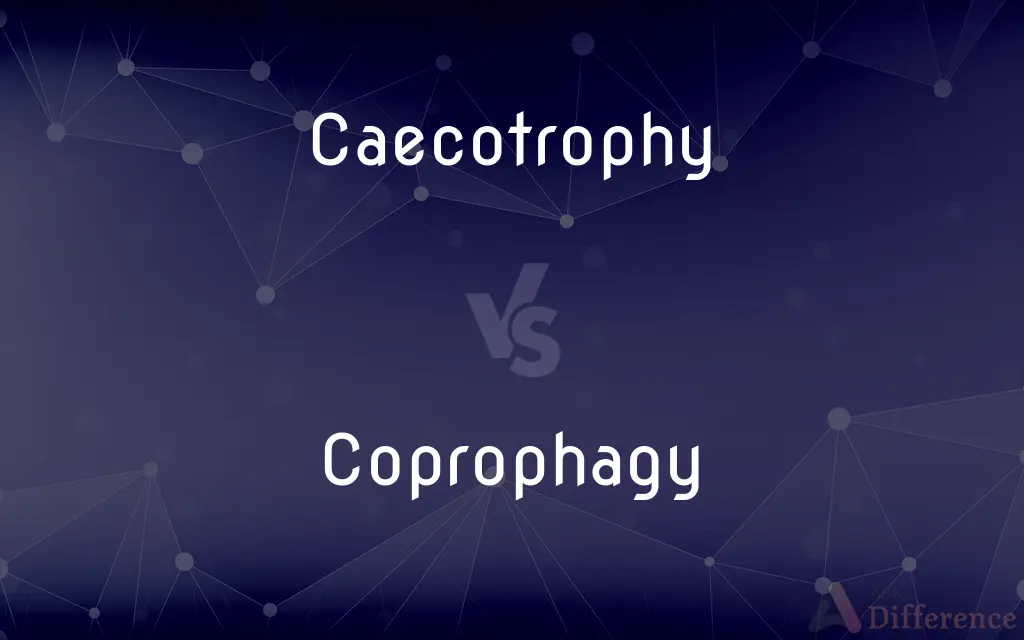Caecotrophy vs. Coprophagy — What's the Difference?
By Tayyaba Rehman & Maham Liaqat — Updated on March 13, 2024
Caecotrophy involves animals consuming cecotropes for nutrient absorption, while coprophagy refers to consuming feces generally.

Difference Between Caecotrophy and Coprophagy
Table of Contents
ADVERTISEMENT
Key Differences
Caecotrophy is a specific behavior observed in some herbivores like rabbits, where they consume cecotropes, nutrient-rich soft pellets directly from their anus. This process allows them to reabsorb nutrients, particularly vitamins and proteins, that were not digested during the first pass through the gut. Whereas coprophagy is a broader term that involves the consumption of feces. This behavior is seen in various animals, including insects, dogs, and sometimes humans, primarily driven by nutritional needs, illness, or stress. It's not limited to consuming one's feces but can include feces from other animals, potentially leading to health risks due to pathogens.
Caecotrophy is an essential part of the digestive process for animals like rabbits and hares, ensuring they get the maximum nutrition from their high-fiber diet. These animals produce two types of fecal pellets: hard, dry pellets, and softer, nutrient-rich cecotropes that are reingested. On the other hand, coprophagy can be a survival tactic or abnormal behavior. In the wild, some species consume feces to obtain nutrients not synthesized by their bodies or to digest cellulose. In domestic settings, it may indicate dietary deficiencies, boredom, or health issues.
The necessity of caecotrophy in some species is due to their specialized digestive systems. Animals like rabbits have a large cecum that houses bacteria to break down cellulose and synthesize essential nutrients. Reingesting cecotropes allows these nutrients to be absorbed. In contrast, coprophagy is not always linked to a specialized digestive process but can be a response to inadequate nutrition, environmental conditions, or instinctive behavior to keep the living area clean.
Both behaviors highlight the adaptability and diverse strategies animals employ to meet their nutritional needs. While caecotrophy is a highly efficient and specialized adaptation in certain herbivores, coprophagy represents a more general survival mechanism that can occur across a broader range of species under various circumstances.
Caecotrophy is a refined behavior aimed at nutrient reabsorption specific to certain herbivores, emphasizing the importance of a specialized diet. Coprophagy, while also related to nutrition, can stem from a wider array of motivations and encompasses a broader spectrum of animals, indicating its versatility as a survival strategy.
ADVERTISEMENT
Comparison Chart
Definition
The consumption of cecotropes, nutrient-rich fecal matter.
The consumption of feces, either one's own or another's.
Primary Consumers
Herbivores like rabbits and hares.
Various, including insects, dogs, and some primates.
Nutritional Purpose
To reabsorb nutrients like vitamins and proteins.
General nutrient intake or specific dietary deficiencies.
Health Implications
Generally healthy and necessary for the animal.
Can be normal or indicate health/dietary issues.
Associated Behavior
Part of the normal digestive process.
Can be due to nutritional needs, stress, or illness.
Compare with Definitions
Caecotrophy
Caecotrophy is when animals like rabbits eat soft fecal pellets to reabsorb nutrients.
The rabbit practiced caecotrophy at dusk, consuming the nutrient-rich cecotropes.
Coprophagy
Coprophagy refers to the consumption of feces for nutritional or other reasons.
The dog's coprophagy worried its owner, prompting a vet visit.
Caecotrophy
Caecotrophy ensures essential nutrient absorption in certain herbivores.
Through caecotrophy, rabbits obtain vitamins and proteins essential for their health.
Coprophagy
Some animals practice coprophagy to extract undigested nutrients.
In the forest, coprophagy is a common survival tactic for some species.
Caecotrophy
In caecotrophy, animals distinguish between two types of fecal matter.
The rabbit selectively consumed the softer, nutrient-rich pellets during caecotrophy.
Coprophagy
Coprophagy can indicate dietary deficiencies or health issues in pets.
Coprophagy in a household pet can be a sign that the diet needs adjustment.
Caecotrophy
Caecotrophy is a critical digestive behavior in some herbivorous species.
Observing caecotrophy in the wild can provide insights into an animal's dietary needs.
Coprophagy
Coprophagy spans a range of behaviors from survival strategies to abnormal activities.
Studying coprophagy can reveal much about an animal's environmental pressures.
Caecotrophy
Caecotrophy involves reingesting partially digested food from the cecum.
The hare engaged in caecotrophy to maximize the nutritional value of its diet.
Coprophagy
In nature, coprophagy may help animals digest tough plant material.
Coprophagy allows some insects to break down cellulose from plants.
Caecotrophy
(biology) In certain mammals, especially rabbits and other lagomorphs, the consumption of food pellets which are naturally produced by means of digestion, retention in the caecum, and expulsion through the anus.
Coprophagy
Feeding on excrement
Coprophagous beetles.
Coprophagy
The eating of feces.
Coprophagy
Eating feces; in human a symptom of some kinds of insanity
Common Curiosities
Why do animals engage in coprophagy?
Animals may engage in coprophagy for nutritional reasons, due to dietary deficiencies, or as part of instinctive behaviors.
Can coprophagy be harmful?
Coprophagy can be harmful if it leads to the ingestion of pathogens or toxic substances, especially if the feces are not the animal's own.
Why do animals practice caecotrophy?
Animals practice caecotrophy to reabsorb essential nutrients like vitamins and proteins from their high-fiber diet.
Is caecotrophy common in all animals?
No, caecotrophy is specific to certain herbivores with specialized digestive systems, like rabbits and hares.
How does caecotrophy benefit animals like rabbits?
Caecotrophy allows animals like rabbits to maximize the nutritional value of their diet by reabsorbing essential nutrients.
What is caecotrophy?
Caecotrophy is the behavior where certain herbivores, like rabbits, consume their cecotropes to reabsorb nutrients.
Is there a health risk associated with caecotrophy?
For animals adapted to caecotrophy, such as rabbits, it is a healthy and necessary part of their digestive process.
What is coprophagy?
Coprophagy is the consumption of feces, either one's own or another's, by various animals for different reasons.
How do animals differentiate between fecal types in caecotrophy?
Animals practicing caecotrophy can distinguish between nutrient-rich cecotropes and regular fecal pellets based on texture and timing of production.
How is caecotrophy different from regular digestion?
Caecotrophy involves the reingestion of partially digested food to further extract nutrients, unlike regular digestion that occurs only once.
Can humans engage in coprophagy?
While extremely rare and generally considered abnormal, there are instances of coprophagy in humans, often related to severe mental health issues.
What role does the cecum play in caecotrophy?
The cecum houses bacteria that break down cellulose and synthesize essential nutrients, making caecotrophy effective for nutrient reabsorption.
Are there any preventive measures for coprophagy in pets?
Preventive measures for coprophagy in pets include ensuring a balanced diet, environmental enrichment, and proper training.
Are there any specific breeds of dogs more prone to coprophagy?
Coprophagy can occur in any breed of dog, but it may be more common in those with higher stress levels or dietary deficiencies.
Can coprophagy be a sign of nutritional imbalance?
Yes, coprophagy can sometimes indicate a nutritional imbalance or deficiency in an animal's diet.
Share Your Discovery

Previous Comparison
Periwig vs. Wig
Next Comparison
Kipper vs. SalmonAuthor Spotlight
Written by
Tayyaba RehmanTayyaba Rehman is a distinguished writer, currently serving as a primary contributor to askdifference.com. As a researcher in semantics and etymology, Tayyaba's passion for the complexity of languages and their distinctions has found a perfect home on the platform. Tayyaba delves into the intricacies of language, distinguishing between commonly confused words and phrases, thereby providing clarity for readers worldwide.
Co-written by
Maham Liaqat













































